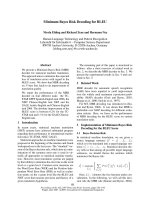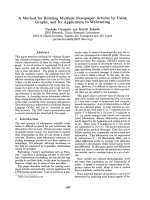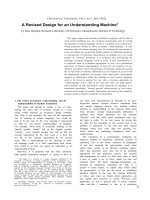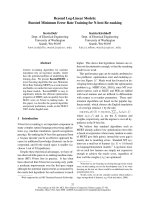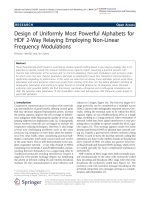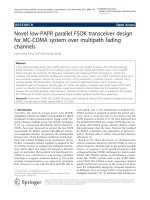Linear Minimum Mean-Square-Error Transceiver Design for Amplify-and-Forward Multiple Antenna Relaying Systems
Bạn đang xem bản rút gọn của tài liệu. Xem và tải ngay bản đầy đủ của tài liệu tại đây (625.47 KB, 130 trang )
Abstract of thesis entitled
Linear Minimum Mean-Square-Error
Transceiver Design for Amplify-and-Forward
Multiple Antenna Relaying Systems
submitted by
Chengwen Xing
for the degree of Doctor of Philosophy
at The University of Hong Kong
July 7, 2010
Multiple-antenna communication system is an important research topic in the
past decades. It increases the data rate or diversity in reception, without occupying additional frequency or time resource. On the other hand, amplify-and-forward
(AF) relaying attracts a lot of attention lately, as it is suitable in cases where the
source cannot directly communicate with the destination, but is possible via a relay
in the middle. The AF relay simply amplifies the received signal without decoding,
thus its operation is favorable in implementation. The combination of multipleinput multiple-output (MIMO) communication and AF relaying technique is currently under consideration for several future wireless communication standards.
With the source, relay and destination all equipped with multiple antennas, a
natural question is how to allocate the limited power resource to make the communication as efficient as possible. This problem is addressed by linear transceiver
design in this thesis. Transceiver designs for point-to-point MIMO or multi-user
MIMO systems have been widely addressed previously. However, for AF MIMO
relaying system, due to the relaying operation, transceiver design becomes more
challenging.
In this thesis, we start with a fundamental three nodes source-relay-destination
MIMO system. The forwarding matrix at relay and equalizer at destination are
jointly designed, under the realistic scenario that channel estimates in both hop
contains Gaussian error. Two robust design algorithms are proposed to minimize
the mean-square-error (MSE) of the output signal at the destination. The first one
is an iterative algorithm with its convergence proved analytically. The other is an
approximated closed-form solution with much lower complexity than the iterative
algorithm.
Next, we consider the AF MIMO orthogonal frequency division multiplexing
(OFDM) system over frequency selective fading channels. Again, the forwarding
matrix at relay and equalizer at destination are jointly designed by minimizing the
total MSE of the output signal at the destination, under channel estimation errors.
However, since OFDM is a multicarrier modulation, transceiver design in such system involves power allocation in both spatial and frequency domains, and thus is
more complicated than the first system. In the proposed solution, the second-order
moments of channel estimation errors in the two hops are first deduced in the frequency domain. Then, the optimal designs for both correlated and uncorrelated
channel estimation errors are investigated. The relationship between the proposed
solutions with existing algorithms is also disclosed.
Finally, we consider the AF MIMO relaying system with multiple users. It corresponds to the case where one base station communicates with multiple terminals
via one relay station. In this system, the source precoder, relay forwarding matrix
and destination equalizer are jointly designed by minimum MSE criterion. Both
uplink and downlink cases are considered. It is found that the uplink and downlink
transceiver designs share some common features and can be solved by a general
iterative algorithm. On the other hand, another proposed algorithm for fully loaded
or overloaded uplink system is shown to include several existing results as special
cases.
(Total words: 477)
Chengwen Xing
Linear Minimum Mean-Square-Error
Transceiver Design for Amplify-and-Forward
Multiple Antenna Relaying Systems
by
Chengwen Xing
B.Eng., Xidian University, Xi’an, P. R. China
A thesis submitted in partial fulfillment of
the requirements for the degree of
Doctor of Philosophy
(Department of Electrical and Electronic Engineering)
at
The University of Hong Kong
July 7, 2010
ii
Copyright c 2010 Chengwen Xing
i
Declaration
I declare that this thesis represents my own work, except where due acknowledgment is made, and that it has not been previously included in a thesis, dissertation or
report submitted to this University or to any other institution for a degree diploma
or other qualifications.
Signed
Chengwen Xing
To my family.
iii
Acknowledgments
First, I am most grateful to my supervisors, Dr. Yik-Chung Wu and Dr. Ricky
Yu-Kwong Kwok. I am very lucky to have two very nice supervisors in my Ph.D.
study. I really appreciate Dr. Kwok for giving me the opportunity to study in the
University of Hong Kong. I am deeply indebted to Dr. Wu for his patient guidance
and encouragement which acquaints me with signal processing and optimization
theory. The door of his office is always open for me, and he selflessly shares with
me his invaluable experience in research. He taught me how to read a paper, how to
find a direction, how to write a paper and even how to be a teacher. I am indebted
to Dr. Wu for all his help, support and kind consideration. This thesis would not be
possible without the help from him.
I would like to express my sincere gratitude to Dr. Shaodan Ma, for her helpful
reviews, insightful comments and selfless help on my research. I would also like to
thank Prof. Tung-Sang Ng for his encouragement and help in my study.
Moreover, I would like to thank my friends I have met in the University of Hong
Kong over the years: Dr. Tyrone Tai-On Kwok, Dr. Fanglei Sun, Dr. Gan Zheng,
Dr. Menglong Jiang, Dr. Xiaoshan Liu, Dr. Yiqing Zhou, Dr. Hongzheng Wang,
Mei Leng, Lanlan He, Dr. Carson Ka-shun Hung, Dr. Jianwu Chen, Dr. Chiu-Wa
Ng, Xiao Li, Jun Zheng, Kun Cai, Xun Cai, Steve, Terry, Jing Xie, Jian Du, Rui
Min and Bin Luo for their kindly help.
iv
I would like to thank the University of Hong Kong for providing financial support via postgraduate studentship and CRCG conference grants. I must also acknowledge the Department of Electrical and Electronic Engineering for all its support to postgraduate students, including the departmental conference grant.
Finally, I am seriously indebted to my parents and my wife for their love. My
wife, Ms. Xingyuan Hao has been waiting for me for 5 years in Beijing during my
postgraduate study. Thanks for her love.
DISCARD THIS PAGE
v
Table of Contents
Page
Declaration . . . . . . . . . . . . . . . . . . . . . . . . . . . . . . . . . . .
i
Acknowledgments . . . . . . . . . . . . . . . . . . . . . . . . . . . . . . .
iii
List of Figures . . . . . . . . . . . . . . . . . . . . . . . . . . . . . . . . . viii
Abstract . . . . . . . . . . . . . . . . . . . . . . . . . . . . . . . . . . . . .
x
1
Introduction . . . . . . . . . . . . . . . . . . . . . . . . . . . . . . . .
1
1.1
1
1
2
4
4
8
9
1.2
1.3
1.4
2
Background . . . . . . . . . . . . . . . . . . . .
1.1.1 Cooperative Communication . . . . . .
1.1.2 Multiple-Input Multiple-Output Systems
1.1.3 AF MIMO Relay Systems . . . . . . . .
Research Motivation and Problems to be Tackled
Organization and Contributions of the Thesis . .
Commonly Used Notations . . . . . . . . . . .
.
.
.
.
.
.
.
.
.
.
.
.
.
.
.
.
.
.
.
.
.
.
.
.
.
.
.
.
.
.
.
.
.
.
.
.
.
.
.
.
.
.
.
.
.
.
.
.
.
.
.
.
.
.
.
.
.
.
.
.
.
.
.
.
.
.
.
.
.
.
Robust Transceiver Design for AF MIMO Relay Systems . . . . . . . 11
2.1
2.2
2.3
2.4
2.5
2.6
2.7
Introduction . . . . . . . . . . . . . . . . . . . . . . .
System Model . . . . . . . . . . . . . . . . . . . . . .
Problem Formulation . . . . . . . . . . . . . . . . . . .
The Proposed Iterative Algorithm . . . . . . . . . . . .
2.4.1 Updating G given F . . . . . . . . . . . . . . .
2.4.2 Updating F given G . . . . . . . . . . . . . . .
2.4.3 Summary and convergence analysis . . . . . . .
The Proposed Closed-Form Solution . . . . . . . . . .
Extension to Weighted MSE Criterion . . . . . . . . . .
Simulation Results and Discussions . . . . . . . . . . .
2.7.1 Simulation Setup . . . . . . . . . . . . . . . . .
2.7.2 Convergence Performance of Iterative Algorithm
.
.
.
.
.
.
.
.
.
.
.
.
.
.
.
.
.
.
.
.
.
.
.
.
.
.
.
.
.
.
.
.
.
.
.
.
.
.
.
.
.
.
.
.
.
.
.
.
.
.
.
.
.
.
.
.
.
.
.
.
.
.
.
.
.
.
.
.
.
.
.
.
11
12
15
17
18
18
20
21
27
29
29
30
vi
Page
2
2.7.3 Effect of Estimation Error σe . . . . . . . . . . . . . . .
2.7.4 Effect of Correlation Coefficients, α and β . . . . . . . .
2.7.5 BER Performance . . . . . . . . . . . . . . . . . . . . .
2.8 Conclusions . . . . . . . . . . . . . . . . . . . . . . . . . . . .
2.9 Proof of q(γi+1 ) is monotonically decreasing and upper bound on
γi+1 . . . . . . . . . . . . . . . . . . . . . . . . . . . . . . . . .
2.10 Proof of MSEU (F) ≥ MSE(F) . . . . . . . . . . . . . . . . . .
˜
2.11 Derivation of optimal F . . . . . . . . . . . . . . . . . . . . . .
3
32
33
34
35
. 37
. 38
. 39
Robust Transceiver Design for AF MIMO OFDM Relay Systems . . 41
3.1
3.2
3.3
3.4
3.5
Introduction . . . . . . . . . . . . . . . . . .
System Model . . . . . . . . . . . . . . . . .
Channel Estimation Error Modeling . . . . . .
Transceiver Design Problem Formulation . . .
Proposed Closed-Form Solution . . . . . . . .
3.5.1 Uncorrelated Channel Estimation Error
3.5.2 Correlated Channel Estimation Error .
3.6 Simulation Results and Discussions . . . . . .
3.7 Conclusions . . . . . . . . . . . . . . . . . .
3.8 Proof of (3.7) . . . . . . . . . . . . . . . . . .
3.9 Proof of (3.17) . . . . . . . . . . . . . . . . .
3.10 Proof of Property 1 . . . . . . . . . . . . . . .
3.11 Proof of Property 2 . . . . . . . . . . . . . . .
3.12 Proof of Property 3 . . . . . . . . . . . . . . .
4
.
.
.
.
.
.
.
.
.
.
.
.
.
.
.
.
.
.
.
.
.
.
.
.
.
.
.
.
.
.
.
.
.
.
.
.
.
.
.
.
.
.
.
.
.
.
.
.
.
.
.
.
.
.
.
.
.
.
.
.
.
.
.
.
.
.
.
.
.
.
.
.
.
.
.
.
.
.
.
.
.
.
.
.
.
.
.
.
.
.
.
.
.
.
.
.
.
.
.
.
.
.
.
.
.
.
.
.
.
.
.
.
.
.
.
.
.
.
.
.
.
.
.
.
.
.
.
.
.
.
.
.
.
.
.
.
.
.
.
.
.
.
.
.
.
.
.
.
.
.
.
.
.
.
.
.
.
.
41
42
44
47
50
56
58
60
65
66
66
68
70
71
LMMSE Transceiver Design for AF MIMO Relaying Cellular Networks . . . . . . . . . . . . . . . . . . . . . . . . . . . . . . . . . . . . 74
4.1
4.2
4.3
4.4
Introduction . . . . . . . . . . . . . . . . . . . . . . . . . . . .
Downlink Transceiver Design . . . . . . . . . . . . . . . . . . .
4.2.1 System model and problem formulation . . . . . . . . . .
4.2.2 Proposed iterative algorithm . . . . . . . . . . . . . . . .
4.2.3 Summary and Initialization . . . . . . . . . . . . . . . .
Uplink Transceiver Design . . . . . . . . . . . . . . . . . . . . .
4.3.1 System model and analogy with downlink design . . . . .
4.3.2 Uplink transceiver design for fully loaded or overloaded
systems . . . . . . . . . . . . . . . . . . . . . . . . . . .
4.3.3 Special cases . . . . . . . . . . . . . . . . . . . . . . . .
Simulation Results and Discussions . . . . . . . . . . . . . . . .
.
.
.
.
.
.
.
74
75
75
78
81
82
82
. 85
. 90
. 91
vii
Page
4.5
5
Conclusions . . . . . . . . . . . . . . . . . . . . . . . . . . . . . 98
Conclusions and Future Research . . . . . . . . . . . . . . . . . . . . 99
5.1
5.2
Conclusions . . . . . . . . . . . . . . . . . . . . . . . . . . . . . 99
Future Research Directions . . . . . . . . . . . . . . . . . . . . . 100
List of References . . . . . . . . . . . . . . . . . . . . . . . . . . . . . . . 102
DISCARD THIS PAGE
viii
List of Figures
Figure
Page
1.1
Cooperative communication system. . . . . . . . . . . . . . . . . . . .
2
1.2
MIMO system. . . . . . . . . . . . . . . . . . . . . . . . . . . . . . .
3
1.3
Single-user AF MIMO relay system. . . . . . . . . . . . . . . . . . . .
4
1.4
Multi-user AF MIMO relay system. . . . . . . . . . . . . . . . . . . .
5
2.1
Amplify-and-forward MIMO relay diagram. . . . . . . . . . . . . . . 12
2.2
Convergence performance of the iterative algorithm with α = 0, β =
2
0.2 and σe = 0.002. . . . . . . . . . . . . . . . . . . . . . . . . . . . . 30
2.3
The MSEs for the closed-form solution and the iterative algorithm for
2
2
different β and σe , when α = 0 and σe = 0.002. . . . . . . . . . . . . 31
2.4
Convergence behaviors of the iterative algorithm with different initial2
izations, when α = 0.6, β = 0.5 and σe = 0.001. . . . . . . . . . . . . 32
2.5
The MSEs for the closed-form solution, the iterative algorithm and
2
the algorithm based on estimated channels only for different σe , when
α = 0.6 and β = 0.45. . . . . . . . . . . . . . . . . . . . . . . . . . . 33
2.6
The MSEs for the two proposed solutions and the algorithm based on
2
estimated channels only for different α, when β = 0.45 and σe = 0.005. 34
2.7
The MSEs for the two proposed solutions and the algorithm based on
2
estimated channels only for different β, when α = 0.45 and σe =
0.005. . . . . . . . . . . . . . . . . . . . . . . . . . . . . . . . . . . 35
2.8
The BERs for the proposed closed-form solution, iterative algorithm
2
and the algorithm based on estimated channels only for different σe ,
when α = 0.45 and β = 0.45. . . . . . . . . . . . . . . . . . . . . . . 36
ix
Figure
Page
3.1
Amplify-and-forward MIMO OFDM relaying. . . . . . . . . . . . . . 42
3.2
2
MSE of received signal at the destination for different σe when α = 0.
3.3
2
MSE of received signal at the destination for different σe when α =
0.4. . . . . . . . . . . . . . . . . . . . . . . . . . . . . . . . . . . . . 63
3.4
MSE of received data at the destination for HSA, SPA and proposed
robust algorithm when α = 0.4. . . . . . . . . . . . . . . . . . . . . . 63
3.5
MSE of received data at the destination for different α. . . . . . . . . . 64
3.6
2
BER of received data at the destination for different σe when α = 0.5.
4.1
Amplify-and-forward MIMO relay downlink and uplink cellular systems. 75
4.2
The convergence behavior of the proposed Algorithm 1 when NB = 4,
NR = 4 and NM,k = 2 with 2 users. . . . . . . . . . . . . . . . . . . . 92
4.3
Total MSEs of detected data of the proposed Algorithm 1 and subopti2
mal algorithms, when NB = 4, NR = 4, NM,k = 2 and Pr /σv =20dB. . 93
4.4
Total MSEs of detected data of the proposed Algorithm 1 with and
without precoder design. . . . . . . . . . . . . . . . . . . . . . . . . . 94
4.5
The convergence behavior of Algorithm 2 for uplink when NB = 4,
NR = 4 and NM,k = 2. . . . . . . . . . . . . . . . . . . . . . . . . . . 95
4.6
Total MSEs of detected data of Algorithm 2 and suboptimal algo2
rithms, when NB = 4, NR = 4, NM,k = 2 and Ps /σn =20dB. . . . . . . 96
4.7
Total MSEs of the detected data of the Algorithm 1, Algorithm 2 with
relaxation and the algorithm proposed in [30]. . . . . . . . . . . . . . . 97
62
65
x
Abstract
Multiple-antenna communication system is an important research topic in the
past decades. It increases the data rate or diversity in reception, without occupying additional frequency or time resource. On the other hand, amplify-and-forward
(AF) relaying attracts a lot of attention lately, as it is suitable in cases where the
source cannot directly communicate with the destination, but is possible via a relay
in the middle. The AF relay simply amplifies the received signal without decoding,
thus its operation is favorable in implementation. The combination of multipleinput multiple-output (MIMO) communication and AF relaying technique is currently under consideration for several future wireless communication standards.
With the source, relay and destination all equipped with multiple antennas, a
natural question is how to allocate the limited power resource to make the communication as efficient as possible. This problem is addressed by linear transceiver
design in this thesis. Transceiver designs for point-to-point MIMO or multi-user
MIMO systems have been widely addressed previously. However, for AF MIMO
xi
relaying system, due to the relaying operation, transceiver design becomes more
challenging.
In this thesis, we start with a fundamental three nodes source-relay-destination
MIMO system. The forwarding matrix at relay and equalizer at destination are
jointly designed, under the realistic scenario that channel estimates in both hop
contains Gaussian error. Two robust design algorithms are proposed to minimize
the mean-square-error (MSE) of the output signal at the destination. The first one
is an iterative algorithm with its convergence proved analytically. The other is an
approximated closed-form solution with much lower complexity than the iterative
algorithm.
Next, we consider the AF MIMO orthogonal frequency division multiplexing
(OFDM) system over frequency selective fading channels. Again, the forwarding
matrix at relay and equalizer at destination are jointly designed by minimizing the
total MSE of the output signal at the destination, under channel estimation errors.
However, since OFDM is a multicarrier modulation, transceiver design in such system involves power allocation in both spatial and frequency domains, and thus is
more complicated than the first system. In the proposed solution, the second-order
moments of channel estimation errors in the two hops are first deduced in the frequency domain. Then, the optimal designs for both correlated and uncorrelated
channel estimation errors are investigated. The relationship between the proposed
solutions with existing algorithms is also disclosed.
xii
Finally, we consider the AF MIMO relaying system with multiple users. It corresponds to the case where one base station communicates with multiple terminals
via one relay station. In this system, the source precoder, relay forwarding matrix
and destination equalizer are jointly designed by minimum MSE criterion. Both
uplink and downlink cases are considered. It is found that the uplink and downlink
transceiver designs share some common features and can be solved by a general
iterative algorithm. On the other hand, another proposed algorithm for fully loaded
or overloaded uplink system is shown to include several existing results as special
cases.
1
Chapter 1
Introduction
1.1 Background
1.1.1
Cooperative Communication
Recently, cooperative communication has gained significant research interest,
due to its great potential to improve reliability, coverage and capacity of wireless
links [1, 2]. Exploiting relay, cooperative communication can take advantage of the
spacial diversity provided by relay to improve the communication between source
and destination. As Fig. 1.1 shows, when the direct link between source and destination is not good enough, source can rely on relay to communicate with destination.
This is a simple application of cooperative communication. In cellular networks
design, deployment of relay station to enlarge coverage of base station is one of the
most important parts in future communication protocols, e.g., LTE, IMT-Advanced
and Winner project [3, 4].
Generally speaking, there are three kinds of cooperative protocols: amplify-andforward (AF), decode-and-forward (DF) and compress-and-forward (CF). For AF
strategy, the relay only amplifies and forwards the received signal from the source
to the destination, without knowing what it has received. While for DF strategy,
the relay will decode the received data and then retransmit it to the destination.
2
Source
Relay
Destination
Figure 1.1 Cooperative communication system.
In compress-and-forward strategy, the data before retransmission at relay will be
compressed first to reduce the redundance.
Among these three protocols, AF is a relatively simple one. It does not need
to know the detailed transmission information at source, such as the modulation
scheme, channel coding strategy, or source coding standard. All operations at relay
are only taken on analogue signal level, so AF strategy is also named as analogue
relay scheme. Because of its simplicity and low implementation complexity, AF
strategy has attracted a lot of researchers’ attention [5–14]. Meanwhile, AF cooperative communication has small time delay and high security, thus also welcomed
by wireless industries, and taken as a candidate of the relay strategies in future
cooperative communication protocols [3, 4].
1.1.2
Multiple-Input Multiple-Output Systems
It is well-known that in fully scattered environment, multi-antenna systems provide substantial spatial diversity and multiplexing gains [15–17]. With multiple
antennas at both transmitter and receiver, multiple data streams can be simultaneously transmitted without any increase in frequency or time resources as shown
in Fig 1.2. Multiple-input multiple-output (MIMO) system is a great success in
wireless communication theory research in the past decades [15–22]. It is also one
of the most important technologies for the third generation mobile communication
systems and beyond.
3
Source
Destination
Figure 1.2 MIMO system.
To exploit the benefits of MIMO systems, transceiver design for MIMO systems
is of great meaning and has been extensively studied [15–17, 19, 21, 22]. Proper
transceiver design can greatly improve the performance of a MIMO system and
can even reduce its sensitivity to channel estimation errors. From different design
purposes or to tackle different problems, the criteria of transceiver design can be
various. In general, there are two criteria for transceiver design: capacity maximization and data mean-square-error (MSE) minimization. The first one mainly
focuses on maximizing the throughput between source and destination. Usually, it
aims at the problem how much information can be transmitted over wireless channel under a transmit power constraint. On the other hand, the design based on the
second criterion tries to solve the problem how accurate a transmit signal can be
recovered from the received signal. Their relationship has been revealed in a landmark paper [23]: capacity maximization transceiver design can be interpreted as a
minimum weighted MSE transceiver design.
From signal processing perspective, in order to minimize the data estimation error from the received signal, MSE is a very important metric for transceiver design
[23–26]. Furthermore, based on implementation consideration, linear minimum
mean-square-error (LMMSE) transceiver is more preferable compared to its nonlinear counterparts which may have prohibitive complexity. Therefore, LMMSE
4
Source
Relay
Destination
Figure 1.3 Single-user AF MIMO relay system.
transceiver design for conventional MIMO systems has been extensively studied in
various scenarios in the past decade [23–26].
1.1.3
AF MIMO Relay Systems
The benefits of multiple-antenna systems can be directly introduced into AF
cooperative communications via deployment of multiple antennas at the source, relay and destination, and such AF MIMO relay systems receive a lot of attention
lately. However, due to the AF operation at relay, the transceiver design is very
challenging. Furthermore, depending on the specific modulation and number of
users, the transceiver design is of different natures and must be tackled in different
ways. In this thesis, we address the problem of transceiver design for single-user
AF MIMO relay systems, where there is only one source, one relay and one destination [13, 14, 27–32] and multiuser AF MIMO relay systems, where multiple mobile
terminals communicate with base station via one relay station [33, 34].
1.2 Research Motivation and Problems to be Tackled
1.2.0.1
Single-user AF MIMO relay systems
In a classical single-user AF MIMO relay system as shown in Fig. 1.3, there
is one source, one relay and one destination. This case corresponds to a practical
scenario when one mobile terminal wants to communicate with base station via the
5
Base station
Relay station
Mobile terminals
Figure 1.4 Multi-user AF MIMO relay system.
help of a relay station. It is the basis of the more complicated AF MIMO relay
systems.
Capacity bounds under different channel state information (CSI) assumptions
for single-user AF MIMO relay systems have been derived in [27], [28]. Transceiver
design maximizing the capacity of single-user AF MIMO relay systems based on
perfect CSI assumption have been studied in [13, 14, 29].
In terms of transceiver design minimizing MSE, for dual-hop AF MIMO relay
systems with single relay, the optimal closed-form solution for joint optimal forwarding and equalizer matrices assuming perfect CSI has been proposed in [30]. It
has also been shown in [30] that the joint design has a better performance than the
various separate design schemes. Furthermore, the joint source precoder, relay forwarding matrix and destination equalizer design for dual hop MIMO-OFDM relay
systems under perfect CSI is proposed in [31]. However, there is no closed-form
solution and an iterative algorithm is proposed.
Notice that the existing algorithms on LMMSE transceiver design for singleuser AF MIMO relay systems require the CSI to be perfectly known. Unfortunately, in practice, CSI is generally obtained through estimation and perfect estimation is very difficult to achieve. Due to limited length of training sequences and/or
6
time-varying nature of wireless channels, channel estimation errors inevitably exist, causing substantial system performance degradation. Robust transceiver design,
which could mitigate such performance degradation by taking the channel estimation errors into account, is therefore of great importance and highly desirable for
practical applications.
When channel uncertainties are considered, both min-max and stochastic (including both probability-based and Bayesian) approaches can be employed. If
quality-of-service (QoS) requirement is considered (e.g., outage probability level
[35, 36]), min-max or probability-based approach is preferred. On the other hand,
if the goal is to minimize an average objective function over channel uncertainties,
e.g., the total MSE of multiple data streams, Bayesian approach is more suitable.
In this thesis, Bayesian robust LMMSE transceiver design for single user AF
MIMO relay systems (including both single carrier and multi-carrier systems) is
investigated. Several existing algorithms can be considered as special cases of our
proposed solutions.
1.2.0.2
Multi-user AF MIMO relay systems
One of the most important application scenarios of cooperative communications
is cellular network. Due to shadowing or deep fading of wireless channels, the base
station may not be able to sufficiently cover all mobile terminals in a cell, especially
those on the edge. Deployment of relay stations is an effective and economic way
to improve the communication quality in cellular networks, as shown in Fig. 1.4.
With multiple antennas at mobile terminals, relay station and base station, a
natural question is how to allocate limited power resource in the spatial domain.
In general, power allocation is equivalent to beamforming matrices design at base


